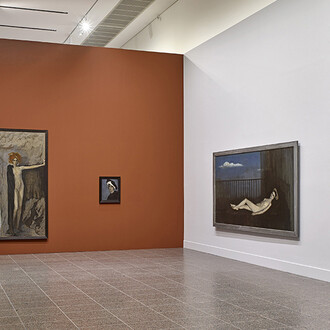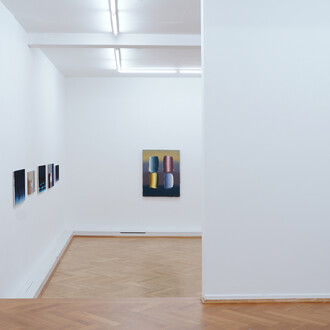Since the foundation of what was then the Städtische Kunstsammlungen zu Düsseldorf in 1913, contemporary art has been part of the Museum’s suite. In 1916, founding director Karl Koetschau formulated the objectives of the Museum in building up the collections and emphasized that “they should show the history of how Düsseldorf art developed through the agency of its main art genres and masters, with selected works from the beginnings through to the present-day, to the extent that these enduring values should have been able to emerge.” (ex: Die Anfänge der städtischen Kunstsammlungen zu Düsseldorf). In the same book he stressed that this regional reference must also be complemented by international works, and in doing so outlined terms of reference that is still applied to acquisitions of modern and contemporary art in the Museum Kunstpalast today. The collection now embraces over 3,000 paintings, sculptures, video works and room installations by artists from the period between 1900 and the present day.
When acquiring contemporary art Karl Koetschau and his curator Walter Cohen largely restricted themselves to works by local artists, graduates of the Düsseldorf Academy, exponents of the Rhineland art scene, members of the Sonderbund movement and Junge Rheinland (Young Rhineland). These were joined by several works of German Expressionism – by artists from the “Brücke”, “Blaue Reiter” and “New Objectivity” movements. But it was striking that absolutely no interest was shown in buying French avant-garde art.
In 1932, Koetschaus’ successor Hans Hupp planned to set up a “Galerie der Neuzeit” or “Gallery of Modernity”; it was officially opened on July 17, 1935 with a clear focus on regional and German art. From 1936 onwards the Nazis forced him to sell works by artists such as Nolde, Pechstein or Dix, and following the confiscation of so-called “degenerate art” the “Galerie der Neuzeit“ was to all intents and purposes abandoned. In all, 101 paintings, 11 sculptures and 526 prints were lost as a result of this barbaric action.
After the end of World War II Werner Doede, the third director of the Düsseldorf Kunstmuseum endeavored to close this gap, and in the first ten years after the war he acquired mainly Expressionist and realistic works; it was only from the second half of the 1950s onwards that these were joined by abstract works from the pre-War avant-garde – Bauhaus, abstraction/création.
From 1969 onwards, the Modern Department of the Museum gained its independence and became a department in its own right distinct from the Painting Department. It was resolved to “specifically and systematically acquire contemporary art in an international context”. From 1976 onwards, Stephan von Wiese headed the Modern Department, and during the late 1970s and 1980s he concentrated on moving this strategy forward. He shifted the emphasis of the collection more strongly towards the artists around Joseph Beuys and his studentsand important exponents of Individuelle Mythologien (Individual mythologies) such as Michael Buthe or Stephan Runge.
When the Museum was transformed into a public private partnership and its name changed to Museum Kunstpalast from 2001 the new Director Jean Hubert Martin, also set a new policy as regards acquisitions of contemporary art by focusing more on works by artists from the former Third World – such as Ghada Amer, Jigya Soma Mashe, El Anatsui, Chen Ruo Bing, and works by artists who address the topics of globalization and its problematic implications.
The Modern Department collection receives valuable support from various support and development models. The Archive of art photography from the Rhineland art scene (AFORK) established in 2003 by Stephan von Wiese now contains around 6,000 photographs and continues to expand thanks to support by the city of Düsseldorf and other sponsors. For many years, the Verein Friends Museum Kunstpalast (former Museumsverein) has supported the work of the Museum through prominent permanent loans and financing exhibition and publication projects. Extensive donations such as those by Wolfgang Hanck (2008) or by Willi Kemp this year complement the holdings. Affiliated with the Department or closely connected to it are the Gerhard und Margarethe Hoehme-Stiftung with the artistic legacy of Gerhard Hoehme and the ZERO Foundation, in which since 2005 large work groups and important archive material of the artists Heinz Mack, Otto Piene and Günther Uecker are kept and studied. Since 2008, a cooperation agreement has been in place with Stadtsparkasse Düsseldorf im Museum Kunstpalast, which enables acquisitions of younger art from the region. There are also important permanent loans and donations by individual persons, which constitute a valuable addition. The general policy remains: To underpin the strengths of the collection, nurture the links to the region (without allowing the quality to sink to a provincial level) and to enrich the collection with international works, which artists located in the region can compete with. Today, an expansion of the Museum seems more desirable than ever as for decades only a small fraction of the extensive holdings can be presented to a wider public.
















